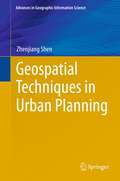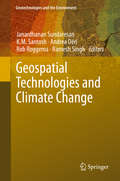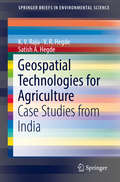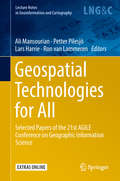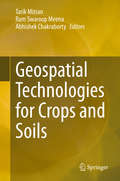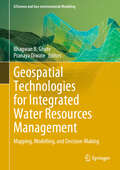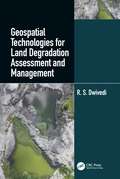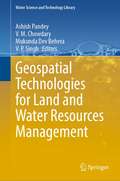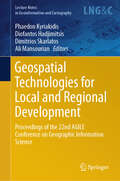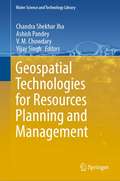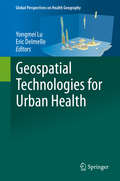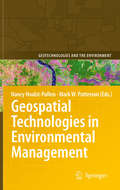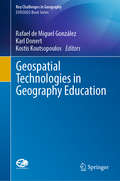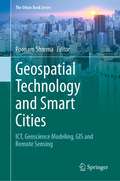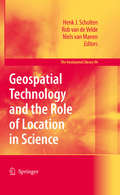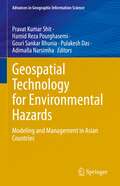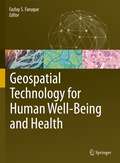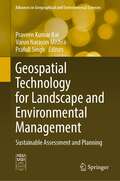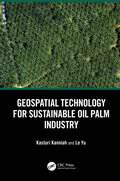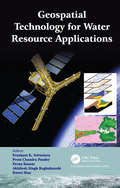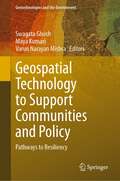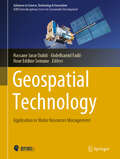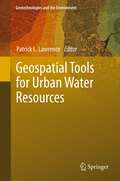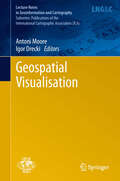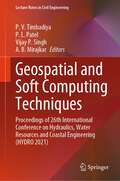- Table View
- List View
Geospatial Techniques in Urban Planning
by Zhenjiang ShenThis work presents cases studies of applications of Geotechnology such as Geography Information Systems, virtual reality and cellular automaton and multi-agent systems in the field of urban planning and design.These are joint research presentations with students and colleagues from Kanazawa University. All these case studies are about application in Japanese or Chinese cities, which are on-field examples reflecting the enormous spread of geo-computation technology. Nevertheless, the concepts have wide applicability to other contexts. The works can be classified into three types of Geotechnological applications at different levels of urban spaces, which are relevant to different kinds of urban planning and development projects. The book is comprised of three parts: Part 1: Geosimulation and land use plan Part 2: Geo Visualization and urban design Part 3: Geography information system and planning support
Geospatial Technologies and Climate Change
by Rob Roggema Ramesh Singh Janardhanan Sundaresan K M Santosh Andrea DériGeospatial Technologies and Climate Change describes various approaches from different countries on how to use geospatial technologies to help solving climate change issues. It also details how different geospatial technologies (remote sensing, Geographical Information System. . . ) can be used to help with climate monitoring and modeling, how to work with them and what to be careful about. This book is written by scientific experts from four different continents. Written in a comprehensive and complete way, this book is essential reading material for graduate and undergraduate students interested in these techniques and in climate change.
Geospatial Technologies for Agriculture: Case Studies from India (SpringerBriefs in Environmental Science)
by K. V. Raju V. R. Hegde Satish A. HegdeThis book uniquely presents accurate and up-to-date information related to crops in small and fragmented agricultural lands with mixed cropping patterns. The book involves research using remote sensing (RS), Global Positioning Systems (GPS) and Geographic Information Systems (GIS) to develop crop inventories in three growing seasons in three villages across India to inform decision makers and planners on best practices for agricultural management. The data analysis of crop details using various geospatial technologies fills in gaps in statistical agriculture research, and provides reliable, replicable and efficient methods for generating agricultural statistics. The book will be of interest to statisticians, planners and decision makers in crop management and production.
Geospatial Technologies for All: Selected Papers Of The 21st Agile Conference On Geographic Information Science (Lecture Notes in Geoinformation and Cartography)
by Ron Van Lammeren Ali Mansourian Petter Pilesjö Lars HarrieThis book presents the research papers accepted for the 21st AGILE Conference on Geographic Information Science, held at Lund University Geographical Information Systems (GIS) Centre, Sweden on 12–15 June 2018. It discusses the role of geospatial technologies in the digitalization of society and is intended primarily for professionals and researchers in fields that can benefit from geoinformation – both within and outside the area of geographic information science.
Geospatial Technologies for Crops and Soils
by Ram Swaroop Meena Tarik Mitran Abhishek ChakrabortyThe sustainable development of the agriculture sector is the only option to meet the demands of increased and economically viable production in a changing climate. This means there is a need to introduce the latest technologies to enhance production, and also help policymakers make decisions for the future. Geospatial technologies & tools, such as remote sensing, geographical information systems (GIS), global positioning systems (GPS), and mobile & web applications, provide unique capabilities to analyze multi-scale, multi-temporal datasets, and support decision-making in sustainable agriculture development and natural resources management. Further, the availability of reliable and timely geospatial information on natural resources and environmental conditions is essential for sustainable agricultural development and food security. Since remote sensing solutions are fast, non-destructive and have large spatial coverage, they can play a significant role in the identification, inventory, and mapping of land resources. Over the past four decades, remote sensing has proved to be a cost-effective and powerful tool to assess crop and soil properties in varying spatial and temporal scales using both visual and digital techniques. Satellite remote sensing coupled with GIS & mobile-app based positional information has emerged as an efficient tool for optimizing input resources, and minimizing cost of production and risk of biotic/ abiotic factors nature to promote sustainable agriculture. This book comprehensively documents the applications of space-based technologies for crop and soil assessments for the sustainable development of agriculture.
Geospatial Technologies for Integrated Water Resources Management: Mapping, Modelling, and Decision-Making (GIScience and Geo-environmental Modelling)
by Bhagwan B. Ghute Pranaya DiwateThis book examines water resources, helps understand complexities in water management, and explains the use of geospatial technology. By 2050, the world will have nearly about 9.8 billion population and which is almost 2.5 to 3 billion added to the present population. Only 3% of world water resources are available for human consumption. Even some resources are polluted because of poor management. Water management is important since it helps determine future irrigation prospects. Management of water resources under set policies and regulations. Water is a more valuable commodity and the world is facing acute water shortages because of drought which is attributed to climate change and overuse. Many rivers are drying up, polluted and encroached. Now the challenge is whether future generations will have enough fresh water for living. Geospatial Technology i.e. Remote Sensing (RS) and GIS have gained considerable interest among earth and hydrological science communities for solving and understanding various complex issues and approaches towards water resources development and management. Water can provide sustainability to any region. Sustainability means that meet the needs of the present, without compromising the ability of future generations to meet their own needs. These are generally integrated to study a variety of natural resources and their characteristics. Major advancements have been accomplished in integrating remote sensing and GIS and they complement each other. RS is used for acquiring information for GIS. Remote sensing and GIS integration provide information on the spatial variation, extent, and potential and limitations of natural resources, which is essential for planning the strategy for sustainable development. Most hydrological or geomorphological models are developed in a GIS framework and these are helpful for the planning and management of water and decision-makers for sustainable development.
Geospatial Technologies for Land Degradation Assessment and Management
by R. S. DwivediThe constant growth of the world’s population and the decline of the availability of land and soil resources are global concerns for food security. Other concerns are the decrease in productivity and delivery of essential ecosystems services because of the decline of soil quality and health by a range of degradation processes. Key soil properties like soil bulk density, organic carbon concentration, plant available water capacity, infiltration rate, air porosity at field moisture capacity, and nutrient reserves, are crucial properties for soil functionality which refers to the capacity of soil to perform numerous functions. These functions are difficult to measure directly and are estimated through indices of soil quality and soil health. Soil degradation, its extent and severity, can also be estimated by assessing indices of soil quality and health. "Geospatial Technology for Land Degradation Assessment and Management" uses satellite imagery and remote sensing technologies to measure landscape parameters and terrain attributes. Remote sensing and geospatial technologies are important tools in assessing the extent and the severity of land and soil degradation, their temporal changes, and geospatial distribution in a timely and cost-effective manner. The knowledge presented in the book by Dr. R.S. Dwivedi shows how remote sensing data can be utilized for inventorying, assessing, and monitoring affected ecosystems and how this information can be integrated in the models of different local settings. Through many land degradations studies, land managers, researchers, and policymakers will find practical applications of geospatial technologies and future challenges. The information presented is also relevant to advancing the Sustainable Development Goals of the United Nations towards global food security.
Geospatial Technologies for Land and Water Resources Management (Water Science and Technology Library #103)
by V. P. Singh Ashish Pandey V. M. Chowdary Mukunda Dev BeheraThis book focuses on the application of geospatial technologies to study the land use land cover (LULC) dynamics, agricultural water management, water resources assessment and modeling, and studies on natural disasters. LULC dynamics is one of the major research themes for studying global environmental change using remote sensing data. The section on LULC dynamics covers the multi-variate criteria for land use and land cover classification and change assessment in the mountainous regions. Further, LULC change detection of the Tons river basin and LULC dynamics at decadal frequency are studied to derive adaptation and mitigation strategies. Landscape-level forest disturbance modeling, together with conservation implications, is also included. The watershed management approach is necessary for comprehensive management of land and water resources of any region, where studies on multi-criteria analysis for rainwater harvesting planning and its impact on land use land cover transformations in rain-fed areas using geospatial technologies are presented in this book.The book will be useful for academics, water practitioners, scientists, water managers, environmentalists, and administrators, NGOs, researchers, and students who are actively involved in the application of geospatial technologies in LULC studies, agricultural water management and hydrological modelling and natural disasters for addressing the challenges being posed by climate change while addressing issues of food and water securities
Geospatial Technologies for Local and Regional Development: Proceedings of the 22nd AGILE Conference on Geographic Information Science (Lecture Notes in Geoinformation and Cartography)
by Ali Mansourian Phaedon Kyriakidis Diofantos Hadjimitsis Dimitrios SkarlatosThis book includes the full research papers accepted by the scientific programme committee for the 22nd AGILE Conference on Geographic Information Science, held in June 2019 at Cyprus University of Technology, Limassol, Cyprus. It is intended primarily for professionals and researchers in geographic information science, as well as those in related fields in which geoinformation application plays a significant role.
Geospatial Technologies for Resources Planning and Management (Water Science and Technology Library #115)
by Vijay Singh Ashish Pandey V. M. Chowdary Chandra Shekhar JhaThis book focuses on the application of geospatial technologies for resource planning and management for the key natural resources, e.g. water, agriculture and forest as well as the decision support system (DSS) for infrastructure development. We have seen in the past four decades that the growing complexities of sustainable management of natural resources management have been very challenging. The book has been written to leverage the current geospatial technologies that integrate the remotely sensed data available from various platforms, the precise locational data providing geospatial intelligence, and the advanced integration tools of Geographical Information Systems (GIS). Geospatial technologies have been used for water resources management employing geomorphological characteristics, analysis of river migration pattern, understanding the large-scale hydrological process, wet land classification and monitoring, analysis of glacial lake outburst flood (GLOF), assessment of environmental flow and soil erosion studies, water quality modelling and assessment and rejuvenation of paleochannels through groundwater recharge. Geospatial technologies have been applied for crop classification and mapping, soil moisture determination using RISAT-1 C-band and PALSAR-2 L-band sensors, inventory of horticulture plantations, management of citrus orchards, crop yield forecasting, rice yield estimation, estimation of evapotranspiration and its evaluation against lysimeter and satellite-based evapotranspiration product for India to address the various issues of the agricultural system management. Geospatial technologies have been used for generation of digital elevation model, urban dynamics assessment, mobile GIS application at grass root level planning, cadastral level developmental planning and e-governance applications, system dynamics for sustainable development, micro-level water resources planning, site suitability for sewage treatment plant, traffic density assessment, geographical indications of India, archaeological applications and disasters interventions to elaborate various issues of DSS for infrastructure development and management. Geospatial technologies have been employed for the generation and reconciliation of the notified forest land boundaries, and also the land cover changes analysis within notified forest areas, forest resource assessment, management and monitoring and wildlife conservation and management. This book aims to present high-quality technical case studies representing the recent developments in the “application of geospatial technologies for resource planning and management”. The editors hope that this book will serve as a valuable resource for scientists and researchers to plan and manage land and water resources sustainably.
Geospatial Technologies for Urban Health (Global Perspectives on Health Geography)
by Yongmei Lu Eric DelmelleThis volume presents a timely collection of research papers on the progress, opportunities, and challenges related to the advancement of geospatial technologies for applications in urban health research and management. The chapter authors cover technologies ranging from traditional GIS and remote sensing technologies, to recently developed tracking/locational technologies and volunteered geographic information (VGI). In four main sections, the book uniquely contributes to the conversation of how geospatial technologies and other GIScience research may be enhanced by addressing the data and challenges presented by urban health issues. The book is intended for those with backgrounds in health and medical geography, social epidemiology, urban planning, health management, and lifestyle research. The book starts with an introduction by the editors, providing an overview of traditional and emerging geospatial technologies and how they each can significantly contribute to urban health studies. Section 1 covers urban health risk and disease, and analyses the spatial and temporal patterns of selected urban health issues. Section 2 addresses urban health service access, and demonstrates how traditional and new geospatial technologies apply to different segments of urban populations facing varied challenges. Section 3 focuses on incorporating geospatial technologies in promoting healthy behaviours and lifestyles in urban settings. Section 4 assesses how geospatial technologies may be incorporated into urban health policies and management practices. Adopting a forward-looking perspective, these papers examine the various health challenges in urban systems, and explore how new and emerging geospatial technologies will need to develop to address these problems.
Geospatial Technologies in Environmental Management
by Mark W. Patterson Nancy Hoalst-PullenThe book explores new approaches and applications of geospatial technologies to understand past, present and future impacts environmental policies and management practices have on the landscape. From forestry to water use, and from wildlife management to agricultural practices, this collection of case studies examines the application of geospatial technologies in managing natural resources, land use, and environmental systems. These case studies are current and written by leading international geospatial technology practitioners. They also incorporate the causative and resultant roles of environmental policies and management within a geospatial context. The book is scientific and research-oriented, yet appealing to a broad audience interested in environmental applications of geospatial technologies, thus making it an important reference source for the fields of GIS, remote sensing, geography, environmental policy and environmental science.
Geospatial Technologies in Geography Education (Key Challenges in Geography)
by Rafael de Miguel González Kostis Koutsopoulos Karl DonertThis book addresses new pedagogies focusing on the use of geospatial technologies and geomedia in the classroom. Today, geospatial technologies are substantially influencing geography teaching and learning, particularly in secondary education. Web-GIS, virtual globes, storytelling, maps and apps for mobile devices are transforming the nature and design of geography curricula, instructional processes, didactics, resources and assessments. Undoubtedly, geography is among those school subjects that have benefited most from the implementation of new technologies in the classroom. Geospatial technologies can be used to develop inquiry-based learning or project-based learning pedagogies and help students to acquire spatial reasoning and spatial citizenship skills in the context of education for sustainable development.This book highlights a range of initiatives, projects and educational practices – from several European countries and settings – related to geospatial challenges in geography education. Given its scope, it will be equally appealing to scientists, students and teachers of geography and other fields using geospatial technologies and geomedia.
Geospatial Technology and Smart Cities: ICT, Geoscience Modeling, GIS and Remote Sensing (The Urban Book Series)
by Poonam SharmaThis book presents fundamental and applied research in developing geospatial modeling solutions to manage the challenges that urban areas are facing today. It aims to connect the academics, researchers, experts, town planners, investors and government officials to exchange ideas. The areas addressed include urban heat island analysis, urban flood vulnerability and risk mapping, green spaces, solar energy, infrastructure management, among others. The book suggests directions for smart city research and outlines practical propositions. As an emerging and critical area of research and development, much research is now being done with regard to cities. At the international level and in India alike, the “smart cities” concept is a vital topic for universities and research centers, and well as for civic bodies, town planners and policymakers. As such, the book offers a valuable resource for a broad readership.
Geospatial Technology and the Role of Location in Science
by Rob Velde Henk J. Scholten Niels Van ManenGlobalisation has not led to the 'death of geography'. Intensified relations between communities in different parts of the world have only highlighted the need for understanding and managing phenomena on a variety of geographic scales. From global warming to credit crunch, and from epidemics to terrorism, causes and solutions are sought on local, regional, national as well as inter-continental levels. With the advent of Geospatial Technology, scholars, policymakers and entrepreneurs have valuable tools in hand to proceed. This book offers the first systematic account of the science behind this mental and technological revolution. Tracing the adoption and dissemination of Geospatial Technology in a range of disciplines, it examines the impact this technology has had, and is likely to have, on the explanation of spatial behaviour, phenomena and processes. At the same time, stressing innovative usage, it explores scientific contributions to technology advancement.
Geospatial Technology for Environmental Hazards: Modeling and Management in Asian Countries (Advances in Geographic Information Science)
by Hamid Reza Pourghasemi Gouri Sankar Bhunia Pravat Kumar Shit Pulakesh Das Adimalla NarsimhaThe book demonstrates the geospatial technology approach to data mining techniques, data analysis, modeling, risk assessment, visualization, and management strategies in different aspects of natural and social hazards. This book has 25 chapters associated with risk assessment, mapping and management strategies of environmental hazards. It covers major topics such as Landslide Susceptibility, Arsenic Contaminated Groundwater, Earthquake Risk Management, Open Cast Mining, Soil loss, Flood Susceptibility, Forest Fire Risk, Malaria prevalence, Flood inundation, Socio-Economic Vulnerability, River Bank Erosion, and Socio-Economic Vulnerability. The content of this book will be of interest to researchers, professionals, and policymakers, whose work involves environmental hazards and related solutions.
Geospatial Technology for Human Well-Being and Health
by Fazlay S. FaruqueOver the last thirty years or so, there have been tremendous advancements in the area of geospatial health; however, somehow, two aspects have not received as much attention as they should have received. These are a) limitations of different spatial analytical tools and b) progress in making geospatial environmental exposure data available for advanced health science research and for medical practice. This edited volume addresses those two less explored areas of geospatial health with augmented discussions on the theories, methodologies and limitations of contemporary geospatial technologies in a wide range of applications related to human well-being and health. In 20 chapters, readers are presented with an up-to-date assessment of geospatial technologies with an emphasis on understanding general geospatial principles and methodologies that are often overlooked in the research literature. As a result, this book will be of interest to both newcomers and experts in geospatial analysis and will appeal to students and researchers engaged in studying human well-being and health. Chapters are presenting new concepts, new analytical methods and contemporary applications within the framework of geospatial applications in human well-being and health. The topics addressed by the various chapter authors include analytical approaches, newer areas of geospatial health application, introduction to unique resources, geospatial modeling, and environmental pollution assessments for air, water and soil.Although geospatial experts are expected to be the primary readers, this book is designed in such a way so that the public health professionals, environmental health scientists and clinicians also find it useful with or without any familiarity with geospatial analysis.
Geospatial Technology for Landscape and Environmental Management: Sustainable Assessment and Planning (Advances in Geographical and Environmental Sciences)
by Praveen Kumar Rai Varun Narayan Mishra Prafull SinghGeospatial technology is a combination of state-of-the-art remote sensing and technology for geographic information systems (GIS) and global navigation satellite systems (GNSS) for the mapping and monitoring of landscapes and environment. The main thrust of using geospatial technology is to understand the causes, mechanisms, and consequences of spatial heterogeneity, while its ultimate objective is to provide a scientific basis for developing and maintaining ecologically, economically, and socially sustainable landscapes. This book presents new research on the interdisciplinary applications of geospatial technology for identification, assessment, monitoring, and modelling issues related to landscape, natural resources, and environmental management. The book specifically focuses on the creation, collection, storage, processing, modelling, interpretation, display, and dissemination of spatio-temporal data, which help to resolve environmental management issues including ecosystem change, resource utilization, land use management, and environmental pollution. The positive environmental impacts of information technology advancements with regard to global environmental and climate change are also discussed. The book addresses the interests of a wide spectrum of readers who have a common interest in geospatial science, geology, water resource management, database management, planning and policy making, and resource management.
Geospatial Technology for Sustainable Oil Palm Industry
by Kasturi Kanniah Le YuOil palm cultivation is known to be one of the leading causes of deforestation and degradation of the environment. This book introduces and explains the application of geospatial technology to an established and important tropical agricultural industry for responsible and sustainable management.
Geospatial Technology for Water Resource Applications (100 Key Points)
by Prashant K. Srivastava Pavan Kumar Prem Chandra Pandey Akhilesh Singh Raghubanshi Dawei HanThis book advances the scientific understanding, development, and application of geospatial technologies related to water resource management. It presents recent developments and applications specifically by utilizing new earth observation datasets such as TRMM/GPM, AMSR E/2, SMOS, SMAP and GCOM in combination with GIS, artificial intelligence, and hybrid techniques. By linking geospatial techniques with new satellite missions for earth and environmental science, the book promotes the synergistic and multidisciplinary activities of scientists and users working in the field of hydrological sciences.
Geospatial Technology to Support Communities and Policy: Pathways to Resiliency (Geotechnologies and the Environment #26)
by Varun Narayan Mishra Maya Kumari Swagata GhoshThis book covers theoretical concepts of climate change related phenomena, different components of geospatial technology and application of geospatial technology on analysis of climate changes. Besides the book will also cover different characteristics of climate resilience, how resilience relates to the adaptation and mitigation and role of geospatial science, techniques, and tools in building climate resilience of a society. This text is suitable for researchers, academicians, urban planners, environmentalists, policy makers, scientists, ecologists, administrators etc.
Geospatial Technology: Application in Water Resources Management (Advances in Science, Technology & Innovation)
by Hassane Jarar Oulidi Abdelhamid Fadil Nour Eddine SemaneThis book aims to exchange and share the experiences and research results on the geospatial technology applied in water resources management. It will present the most recent innovations, trends, challenges encountered and the solutions adopted in the area of geospatial technology. It will be beneficial for academicians, scientists, meteorologists, and consultants working in the field of water resources management.
Geospatial Tools for Urban Water Resources
by Patrick L. LawrenceThis book examines the application of geotechniques to address a wide range of issues facing urban water resources. Growing populations leading to urbanization and related development have lead to problems associated with water quality, storm water management, flood control, environmental health, and related ecosystem impacts. Major cities and other urban areas are facing challenges in addressing the implications of impacts to water resources. Recent innovations in geotechnologies, including Geographic Information Science (GIS), remote sensing, and other spatial tools and techniques, provide great opportunities and potential to assist in dealing with these problems. This volume provides a series of case studies that examine the application of new methods and approaches in a range of geotechnologies as utilized to better understand and resolve urban water resource concerns in communities throughout the world. Computer based mapping, spatial analysis, satellite imagery, decision support systems, web based applications, aerial photography, and other methods are highlighted by their development and application. The research presented in this volume will provide for an excellent source of knowledge and learning to assist professionals, experts, and students with a better understanding of how the use of geotechnologies can be used to assist urban communities to address water resource challenges.
Geospatial Visualisation
by Antoni Moore Igor DreckiThis book is a selection of chapters evolved from papers on completed research submitted to GeoCart'2010 / the 1st ICA Regional Symposium on Cartography for Australasia and Oceania, held in Auckland, New Zealand, 1st -3rd September 2010. All of the chapters have been updated and revised thoroughly. They have been blind peer reviewed by two referees of international research standing in geospatial science, mostly in the subdisciplines of cartography and geovisualisation. The book features cutting edge topics such geovisual analytics, mobile / Web 2.0 mapping, spatiotemporal representation, cognitive cartography, historical mapping and 3D technology.
Geospatial and Soft Computing Techniques: Proceedings of 26th International Conference on Hydraulics, Water Resources and Coastal Engineering (HYDRO 2021) (Lecture Notes in Civil Engineering #339)
by Vijay P. Singh P. V. Timbadiya P. L. Patel A. B. MirajkarThis book comprises the proceedings of the 26th International Conference on Hydraulics, Water Resources and Coastal Engineering (HYDRO 2021) focusing on broad spectrum of emerging opportunities and challenges in the field of soft computing and geospatial techniques in water resources engineering. It covers a range of topics, including, but not limited to, satellite derived data for hydrologic applications, GIS and RS applications in water resources management, rainfall and streamflow prediction, hydro-informatics, data driven and artificial intelligent based hydrological modelling, optimization of water resources systems, etc.Presenting recent advances in the form of illustrations, tables, and text, it offers readers insights for their own research. In addition, the book addresses fundamental concepts and studies in the field of Soft Computing and Geospatial Techniques in Water Resources Engineering, making it a valuable resource for both beginners and researchers wanting to further their understanding of hydraulics, water resources and coastal engineering.
